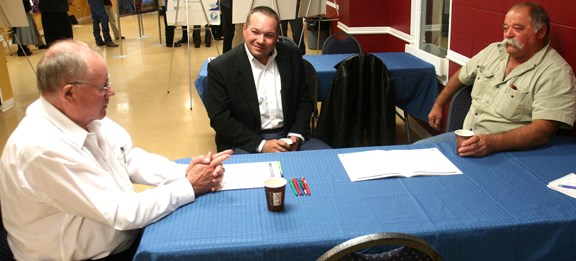The Government of Alberta held an information session to discuss the Land-use Framework and work towards a Lower Athabasca regional plan at the C2 on Sept. 8. The session was held to provide the public with up-to-date information, including the latest advice from the Regional Advisory Council, and also to encourage the public to provide feedback and input towards the development of a regional plan for the Lower Athabasca region.
The development of a regional plan is only the first stage. This session is part of the second stage, with the third stage still to come, explained Neal Watson, an Alberta Government spokesperson. Watson wanted to make it clear to the public that no plans have been completed yet and the evening was "about getting the input and feedback from the public."
He said that prior to this session, the RAC assessed the situation in the region and produced a vision document stating its ideas, objectives and vision for the future of the Lower Athabasca region. Both the citizens and the Government of Alberta were then able to scrutinize this document and provide feedback in order to create a draft regional plan, which will likely be written and released sometime in the coming year. The third stage of this process will occur once a draft regional plan has been written. The public will again be asked to scrutinize the draft plan and provide further feedback. This will lead to the production of a regional plan, which can then be provided to cabinet for approval. Where this plan differs from other land-use plans is that it will be enforceable under the Alberta Land and Stewardship Act.
"This is the first land-use planning process with an act to back it up - it has teeth," said Dave Bartesko, a senior consultant with the Land-use Secretariat.
With legislation to back it up, the plan will ensure that government, both provincial and municipal, as well as all types of industry, comply with the regulations set out in the regional plan.
"We need greater public participation because it is important for the public to understand the plan," said Clarence Makowecki, an Albertan farmer who formerly sat on the RAC. "The consequences of land use in this region are huge, especially with industry driving Alberta's economy, land-use planning is so important for the future of Alberta."
"It's a whole new way of doing business, which could be something that scares some people," said Crystal Damer, executive director at the Land-use Secretariat. "But it will be a balance between finding what works and what doesn't and also where we want to be in the future." She also explained that even once the plan is written and potentially passed by cabinet, it would not be set in stone or unable to change. In fact, each regional plan will be reviewed every five years in order to keep them current with the desires of Albertans and the circumstances of Alberta.
But there are some that are still uncertain about the regional plan and its effects.
Mayor Ernie Isley said, "The process has been dragging on for a long time, I'm still waiting to see the meat and potatoes of this." He added, "I like the old system, but I am not sure we should go back to it, or get rid of it completely."
There were suggestion boards at the session set up throughout the room for anyone to add to. However, by the end of the evening there were few suggestions on any specific board.
The RAC, which has since been disbanded after completing their mandate, was made up of 15 members. As described on the Government of Alberta website, these members represented a cross-section of interests, including municipal and provincial bodies, industry, Aboriginal groups and environmental concerns. They provided strategic advice for development of the regional plan that is consistent with the vision and outcomes of the Land-use Framework.
If you were unable to attend this particular session, there will be sessions going on throughout the region during the entire month of September. You can also go online to www.landuse.alberta.ca for information on land-use and regional planning, as well as session times and locations. Furthermore, if you would like to have your voice heard, there is a workbook available on the website, which can be submitted with your feedback to the Government of Alberta. They will then take all the completed workbooks into consideration when writing the draft regional plan.



